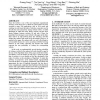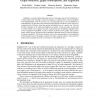180 search results - page 4 / 36 » Learning random walks to rank nodes in graphs |
WEBI
2005
Springer
14 years 29 days ago
2005
Springer
Several algorithms based on link analysis have been developed to measure the importance of nodes on a graph such as pages on the World Wide Web. PageRank and HITS are the most pop...
CORR
2010
Springer
13 years 7 months ago
2010
Springer
Predicting the occurrence of links is a fundamental problem in networks. In the link prediction problem we are given a snapshot of a network and would like to infer which interact...
ICML
2006
IEEE
14 years 8 months ago
2006
IEEE
We consider the problem of clustering in its most basic form where only a local metric on the data space is given. No parametric statistical model is assumed, and the number of cl...
SIGIR
2006
ACM
14 years 1 months ago
2006
ACM
Since the website is one of the most important organizational structures of the Web, how to effectively rank websites has been essential to many Web applications, such as Web sear...
ITA
2006
13 years 7 months ago
2006
PageRank is a ranking method that assigns scores to web pages using the limit distribution of a random walk on the web graph. A fibration of graphs is a morphism that is a local i...


